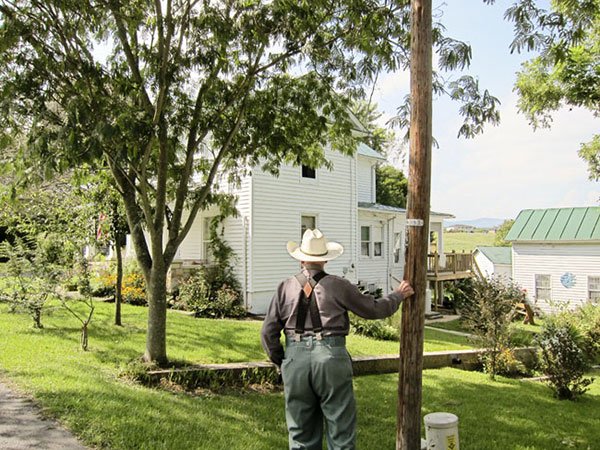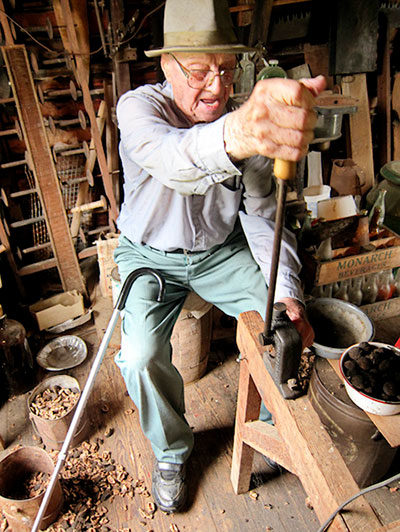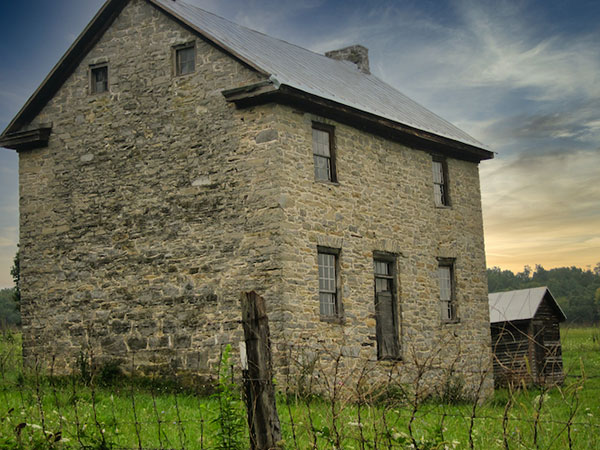It had been years since I last visited the home of my heart, the only place where I can breathe freely. Conicville is in Shenandoah County in the Valley of Virginia, bordered by the Allegheny Mountains. It consists of a church, a cemetery, and a scattering of houses and farms. In 2012, I traveled to meet my 98-year-old cousin. His farm had recently been designated a Virginia Century Farm, land that has been in the same family for a hundred years. Noah’s farm has been in his family 250 years.

Noah lived alone in the original farmhouse, still drove, and possessed a mind as clear as the Shenandoah River. He wrote out our genealogy to show where my side and his descended from two brothers, leading back to the first Dellinger’s arrival from Germany in 1711. He took me and my husband to his barn, where we stepped back a hundred years. A spring skipped through a concrete trough in the floor. Everywhere were antique implements and equipment. Noah demonstrated a walnut cracker his uncle had invented and gave us a bag of black walnuts.


My memories of Conicville were the funerals of my mother’s aunts and uncles. Afterward, we gathered at a relative’s house for ham biscuits, custardy corn pudding, and mile-high coconut cake. I’d walk down the road to an old stone house and wondered if the person who’d lived there had been murdered (I was ten and read too many mysteries).

Each funeral trip, I felt I was coming home. Something about the mountains like cupped hands, the green rolling hills, and dirt roads made me want to run for the joy of it. I loved the peacefulness, the way people talked, and seeing my hazel eyes in distant kin.
Noah had a map of Conicville in 1920. I was astonished to learn the village had three undertakers (my grandfather, my great-grandfather, and a cousin), a blacksmith (who made my mother a tiny horseshoe), stores, post office, pharmacy, garage, barber, telephone switchboard, all but the four-room school in the owners’ houses. Then Noah took me to the house where my mother had been born. My mother had never mentioned it.
In 1924, my grandfather moved his family to Manassas to find work (too many undertakers) when my mother was six. Summers, she returned to the Valley to stay with her aunt and uncle, and helped bake pies, can vegetables, serve hands during the harvest — hard but honest work. The same work Noah did on his land.
My husband and I went to Shenandoah County in August to visit Noah and take in the county fair. After Noah turned 102, he moved into his nephew’s home. He still told me stories, though it wasn’t the same. In his last Christmas card, December 2020, Noah wrote: “I believe I’m making history.” Months later, he died three days before his 106th birthday.
 When I heard the news, I reached for Alan Garner’s The Stone Book published in 1976 as the first of a quartet of novellas. It is set in 1846 Cheshire, England, and tells the story of a stonemason and his daughter, Mary. Although Garner was a prize-winning children’s author, critics lambasted his new book. Some said it wasn’t for children at all. As Neil Philip pointed out in A Fine Anger, Garner’s semi-autobiographical text is “simple, slow, uncomplicated [with a] meditative quality.” Yet children did read it.
When I heard the news, I reached for Alan Garner’s The Stone Book published in 1976 as the first of a quartet of novellas. It is set in 1846 Cheshire, England, and tells the story of a stonemason and his daughter, Mary. Although Garner was a prize-winning children’s author, critics lambasted his new book. Some said it wasn’t for children at all. As Neil Philip pointed out in A Fine Anger, Garner’s semi-autobiographical text is “simple, slow, uncomplicated [with a] meditative quality.” Yet children did read it.
Mary climbs the church steeple where her father is working to deliver his “baggin,” his lunch (I wondered if Tolkien borrowed this Cheshire word for the food-loving hobbits). Mary craves to go to school and work as a maid at the manor house:
“I’m fretted with stone picking,” said Mary. “I want to live in a grand house, and look after every kind of beautiful thing you can thing of — old things, brass.”
“By God, you’ll find stone picking’s easier! Lord Stanley doesn’t like his maids to read,” said Father.
In this “Nickety, Nackety, Monday-come-Saturday” life, work carries pride and meaning. Mary’s father breaks a pebble cleanly, then polishes it a certain way so that the “pebble came out with its broken face green and white flakes, shining like wet … It was a stone-cutter’s secret, one of the last taught.” Later he takes her deep into the quarry, gives her a candle, and tells her to slip through a crack. She follows the passage until she sees a bull daubed on a wall. And hundreds of footprints. The secret place is her family’s alone, and like generations before her, Mary is changed. If she can read stone, she’ll know all the stories of the world.
Whenever I visited Noah at his farm, I noticed craftsmanship everywhere: in the sturdy pigpen, handmade tools, furrows of corn straight as die. I’ve lost that connection now. One day I hope to tell Noah’s stories, the way Alan Garner celebrated his family’s culture: “A family of manual craftsmen … served by a different craft of the hand.”
Writing will let me follow the footprints of generations before me. Writing will keep the home of my heart close.

I love this, Candace; thanks for sharing your heart and history. And now I’m looking forward to reading The Stone Book!
Hi Lynne! The book might be hard to find – I had to order my copy. There are three others in the quartet, each covering a different time period in Garner’s home and family history. All are gems!
This is a lovely essay! I also come from a family of undertakers, so nice to know another author who has those same family experiences and roots! I also have a special fondness for any well-written adult fiction set in that Appalachian/ southern Allegheny area. Such a cultural and geographic richness there and pride in craft that seeps into their prose and is embodied in their characters. Your cousin certainly has those qualities and what a gift to have met him. Thanks for sharing!
My favorite story my mother told me was how she and her cousin Raymond, called Happy, played “dead people. Happy was a few years older than my six-year-old mother and should have known better to let her lock him in one of my grandfather’s caskets. Mama skipped off to play and forgot about her poor cousin for a long while. I suspect Happy wasn’t so happy when she finally let him out! And yes, I mentally need this place I’ve never lived in because of the people who worked the land, respected the land, and loved it, as Noah did.
Wonderful writing and photos, a lovely way to start my day! Made me think about family I never got to know in W.Va — some undertakers there, too. Thank you, Candice!
I don’t know why undertaking was such a popular profession. When times were hard my grandfather used to say people were too poor to die (he meant they died but couldn’t afford to pay for funerals). He kept his embalming certificate up to date, even though he went into an entirely different business.